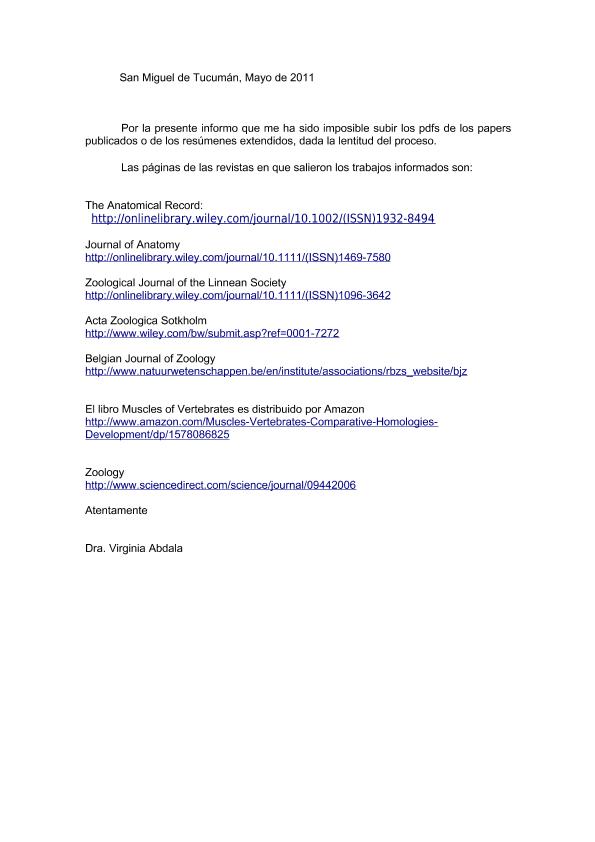Mostrar el registro sencillo del ítem
dc.contributor.author
Abdala, Virginia Sara Luz

dc.contributor.author
Manzano, Adriana Silvina

dc.contributor.author
Tulli, María José

dc.contributor.author
Herrel, Anthony

dc.date.available
2019-07-29T14:01:25Z
dc.date.issued
2009-05
dc.identifier.citation
Abdala, Virginia Sara Luz; Manzano, Adriana Silvina; Tulli, María José; Herrel, Anthony; The Tendinous Patterns in the Palmar Surface of the Lizard Manus: Functional Consequences for Grasping Ability; Wiley Interscience; The Anatomical record Part A; 292; 5-2009; 842-853
dc.identifier.issn
1552-4892
dc.identifier.uri
http://hdl.handle.net/11336/80462
dc.description.abstract
In lizards, distinct patterns of the tendinous structures associated with the forearm flexors have been described. In most lizards, the m. flexor digitorum longus ends in a tendinous plate with an embedded sesamoid, from which tendons run to the terminal phalanx of each digit. This structure is known as the flexor plate. In many polychrotid lizards, however, the flexor digitorum longus muscle is continuous with individual tendons running to each digit, and no complete flexor plate is present. In most geckos, the flexor plate is reduced to a tendinous plate without sesamoid. To evaluate the consequences of these differences in morphology on locomotion and grasping, we compared the use of the fore‐arm and hand in lizards exhibiting three different tendon patterns (Pogona vitticeps, an agamid with a well‐developed flexor plate; Gekko gecko, a gekkonid with a flexor plate, but without an embedded sesamoid; Anolis equestris, a polychrotid without flexor plate, but showing independent tendons running to each digit) while moving on different substrates. We found that the presence of a flexor plate with sesamoid bone prevents digital flexion and creates a rather stiff palmar surface in P. vitticeps. This configuration makes it impossible for P. vitticeps to grasp narrow branches and results in a strongly impaired locomotor performance on narrow substrates. Both G. gecko and A. equestris can flex the palms of their hands and their fingers more extensively, and do so when moving on narrow substrates. We suggest that the reduction of the flexor plate in both G. gecko and A. equestris allows these animals to move effectively on narrow substrates.
dc.format
application/pdf
dc.language.iso
eng
dc.publisher
Wiley Interscience
dc.rights
info:eu-repo/semantics/openAccess
dc.rights.uri
https://creativecommons.org/licenses/by-nc-sa/2.5/ar/
dc.subject
Flexor Plate
dc.subject
Forearm Muscles
dc.subject
Grasping Hand
dc.subject
Lizards
dc.subject
Palmar Sesamoid
dc.subject
Tendons
dc.subject.classification
Zoología, Ornitología, Entomología, Etología

dc.subject.classification
Ciencias Biológicas

dc.subject.classification
CIENCIAS NATURALES Y EXACTAS

dc.subject.classification
Otros Tópicos Biológicos

dc.subject.classification
Ciencias Biológicas

dc.subject.classification
CIENCIAS NATURALES Y EXACTAS

dc.title
The Tendinous Patterns in the Palmar Surface of the Lizard Manus: Functional Consequences for Grasping Ability
dc.type
info:eu-repo/semantics/article
dc.type
info:ar-repo/semantics/artículo
dc.type
info:eu-repo/semantics/publishedVersion
dc.date.updated
2019-07-11T18:30:42Z
dc.journal.volume
292
dc.journal.pagination
842-853
dc.journal.pais
Estados Unidos

dc.journal.ciudad
New York
dc.description.fil
Fil: Abdala, Virginia Sara Luz. Fundación Miguel Lillo. Dirección de Zoología. Instituto de Herpetología; Argentina. Consejo Nacional de Investigaciones Científicas y Técnicas. Centro Científico Tecnológico Conicet - Tucumán. Instituto de Biodiversidad Neotropical. Universidad Nacional de Tucumán. Facultad de Ciencias Naturales e Instituto Miguel Lillo. Instituto de Biodiversidad Neotropical. Instituto de Biodiversidad Neotropical; Argentina
dc.description.fil
Fil: Manzano, Adriana Silvina. Provincia de Entre Ríos. Centro de Investigaciones Científicas y Transferencia de Tecnología a la Producción. Universidad Autónoma de Entre Ríos. Centro de Investigaciones Científicas y Transferencia de Tecnología a la Producción. Consejo Nacional de Investigaciones Científicas y Técnicas. Centro Científico Tecnológico Conicet - Santa Fe. Centro de Investigaciones Científicas y Transferencia de Tecnología a la Producción; Argentina
dc.description.fil
Fil: Tulli, María José. Fundación Miguel Lillo. Dirección de Zoología. Instituto de Herpetología; Argentina. Consejo Nacional de Investigaciones Científicas y Técnicas. Centro Científico Tecnológico - Tucumán. Unidad Ejecutora Lillo; Argentina
dc.description.fil
Fil: Herrel, Anthony. Muséum National d'Histoire Naturelle; Francia. Centre National de la Recherche Scientifique; Francia
dc.journal.title
The Anatomical record Part A
dc.relation.alternativeid
info:eu-repo/semantics/altIdentifier/doi/https://doi.org/10.1002/ar.20909
dc.relation.alternativeid
info:eu-repo/semantics/altIdentifier/url/https://onlinelibrary.wiley.com/doi/10.1002/ar.20909
Archivos asociados
